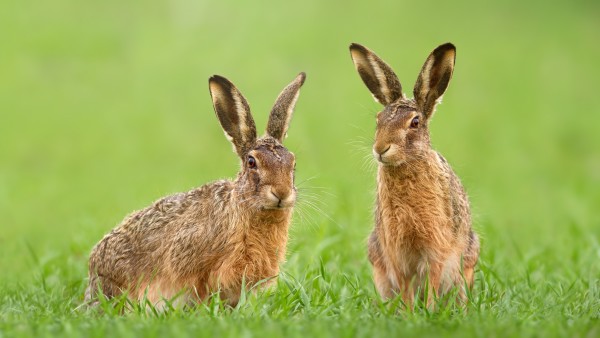Happy Easter from our TAPS bloggers - can you tell your bunnies from your hares?
Hello all, TAPS wildlife team here
Well spring is officially here, although with the weather we’ve been having it doesn't always feel like it! Easter is also around the corner, so everyone always thinks of little chicks, lambs and bunnies as well as of course, chocolate eggs.
We are sure most of you will have started to notice the changing season, buds are forming on the trees, flowers are starting to bloom, and we've seen the welcome return of bumble bees and butterflies. It's also mating season for most animals and birds and if you look into ponds you may be able to spot frogspawn. Claire certainly did on a wildlife walk where there were hundreds of noisy frogs going about their breeding business. You may also be lucky enough to see hares boxing in fields, a true spring sight.
Here at the Hub we’ve noticed the birds are all pairing up. We’re lucky enough to have two pairs of greenfinches building nests, also the blackbirds and bluetits who have taken up residence in one of our bird boxes. Some of our birds are returning after their winter migration and those who spent the winter here are returning to their breeding grounds abroad. It’s lovely to hear all the birdsong in the mornings, and soon everywhere will be alive with baby birds and animals.
This month's focus is on the brown hare. Norfolk nationally holds an important population of them, whilst in other areas these beautiful creatures have declined, we are lucky in Norfolk as it's a stronghold for them here.
So how do you tell the difference between a hare and a rabbit?
- The hare has distinctive larger black tipped ears.
- They also have longer hind legs.
- Hares are larger than rabbits.
- Hares do not dig burrows like rabbits, instead nesting above ground.
- Hares do not have a particular home, and instead will move from place to place.
- Hares make a shallow indent in the ground known as a form where they lay down very still with their long ears pressed along their backs, making them hard to spot.
- Hares are the fastest UK land mammal reaching 45 mph when running.
- Did you know there's a domestic breed of rabbit called a Belgian hare, which was bred to resemble a wild European hare.
There's a lot more wildlife to watch out for in the coming months, those that have been hibernating like hedgehogs and bats will be coming out of their winter sleep. As always if you find a poorly hedgehog or are concerned about any wild animal, seek advice from a rescue centre like PACT Animal Sanctuary who do a wonderful job in looking after our wild friends.
https://www.pactsanctuary.org/
We’ve been busy at the Hub planting flowers and shrubs that will attract, birds, bees, butterflies and other insects that are all an important part of the eco system in our gardens.
So, until next time have a lovely Easter and keep watching wildlife and help where you can.
Helen, Tim, Justin, Lucie, Craig, Jasmine, Mark, Stephen & Claire

Two hares in a field
< Back to News
